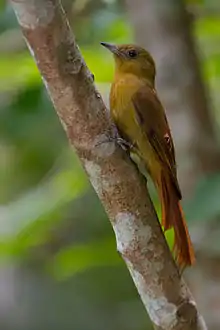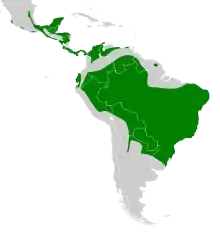Olivaceous woodcreeper
The olivaceous woodcreeper (Sittasomus griseicapillus) is a passerine bird of the tropical Americas. It belongs to the true woodcreepers (tribe Dendrocolaptini) of the ovenbird family (Furnariidae).
| Olivaceous woodcreeper | |
|---|---|
 | |
| Scientific classification | |
| Kingdom: | Animalia |
| Phylum: | Chordata |
| Class: | Aves |
| Order: | Passeriformes |
| Family: | Furnariidae |
| Genus: | Sittasomus Swainson, 1827 |
| Species: | S. griseicapillus |
| Binomial name | |
| Sittasomus griseicapillus (Vieillot, 1818) | |
 | |
It is the only member of the genus Sittasomus, but includes 15 vocally and morphologically distinct subspecies in 5 groups, some of which are candidates for a future split.[2]
Description and ecology
This small woodcreeper is a slender bird, typically 13.1–19.3 cm (5.2–7.6 in) long, and weighing 8.6–18 g (0.30–0.63 oz).[2] The head, upper back and underparts are lighter or darker greyish olive, and the wings, tail and lower back are light rufous. The bill is short and thin.
The normal call is a fast, high-pitched trill wu-wu-wu-we-we-we-we-ee-ee-ee-ee-we-we-we-we, but this varies geographically.[2]
It breeds from southern Mexico through tropical Central and South America to northern Argentina and Uruguay, and also on Tobago. The species is found throughout the Amazon basin, but is absent from its lowest reaches, including much of the adjacent Guyanas.
There, the subspecies of the northeastern Amazon (S. g. axillaris) ranges at least to the Pakaraima Mountains, where it is fairly common at 1,200–1,400 m (3,900–4,600 ft) ASL, descending to about 850 m (2,790 ft) ASL on occasion. The olivaceous woodcreeper has also been recorded from extreme southern Guyana and the Essequibo River (which may be its eastern limit in the region). It is apparently completely absent from eastern Guyana eastwards through Suriname and French Guiana.[3]
In Uruguay, the olivaceous woodcreeper was found for the first time in 1997 in the gallery forests of the Yaguarón River, in Cerro Largo Department.[4] Since then, it has also been recorded near Cuchilla de Mangrullo, as well as in the Sierra de los Ríos.[5]
The olivaceous woodcreeper is a common and widespread bird of forests and other woodlands. It feeds on insects and spiders. It normally forages on tree trunks or large branches or on the ground, usually singly.[nb 1]
These birds may associate with foraging groups of golden lion tamarins (Leontopithecus rosalia) to snatch prey startled by the monkeys. They can also be occasionally seen catching flying prey like termites in mid-air, and will sometimes join mixed-species feeding flocks. In some places (e.g. in the Serra de Paranapiacaba of Brazil), they may even form a core species of such flocks.[6][7][8]
It builds a nest lined with dead leaves in a tree hole and lays three white eggs.
Due to its extremely wide range, the olivaceous woodcreeper is not considered a threatened species by the IUCN.[1]
Notes
- ffrench and/or Hilty seem to claim this species does not join mixed flocks often. This is contradicted by Machado, Olson & Alvarenga and O'Shea. Possibly different behaviours are associated with different taxa subspecies?
References
- BirdLife International (2012). "Sittasomus griseicapillus". IUCN Red List of Threatened Species. 2012. Retrieved 26 November 2013.CS1 maint: ref=harv (link)
- Patten, Michael A. (2011). Schulenberg, T.S. (ed.). "Overview – Olivaceous Woodcreeper (Sittasomus griseicapillus)". Neotropical Birds Online. Ithaca, NY, US: Cornell Lab of Ornithology. Retrieved 17 July 2014.
- O'Shea, B.J.; Christopher, M.; Claramunt, Santiago; Schmidt, Brian K.; Gebhard, Christina A.; Schmitt, C. Gregory; Erskine, Kristine T. (2007). "New records for Guyana, with description of the voice of Roraiman Nightjar Caprimulgus whitelyi" (PDF). Bulletin of the British Ornithologists' Club. 127 (2): 118–128.
- Claramunt, Santiago (1998). "Todirostrum plumbeiceps y Sittasomus griseicapillus, dos Passeriformes nuevos para Uruguay (Aves)" (PDF). Comunicaciones Zoológicas del Museo de Historia Natural de Montevideo. 12 (189): 1–4.
- Azpiroz, Adrián B.; Menéndez, José L. (2008). "Three new species and novel distributional data for birds in Uruguay". Bulletin of the British Ornithologists' Club. 128 (1): 38–56.
- Machado, C.G (1999). "A composição dos bandos mistos de aves na Mata Atlântica da Serra de Paranapiacaba, no sudeste brasileiro" [Mixed flocks of birds in Atlantic Rain Forest in Serra de Paranapiacaba, southeastern Brazil] (PDF). Revista Brasileira de Biologia (in Portuguese). 59 (1): 75–85. doi:10.1590/S0034-71081999000100010.
- Olson, Storrs L.; Alvarenga, Herculano M.F. (2006). "An extraordinary feeding assemblage of birds at a termite swarm in the Serra da Mantiqueira, São Paulo, Brazil" (PDF). Revista Brasileira de Ornitologia. Sociedade Brasileira de Ornitologia. 14 (3): 297–299. Archived from the original (PDF) on 2008-12-17.
- de Mello Beisiegel, Beatriz (2007). "Foraging Association between Coatis (Nasua nasua) and Birds of the Atlantic Forest, Brazil". Biotropica. The Association for Tropical Biology and Conservation. 39 (2): 283–285. doi:10.1111/j.1744-7429.2006.00255.x.
Further reading
External links
| Wikimedia Commons has media related to Sittasomus griseicapillus. |
| Wikispecies has information related to Sittasomus griseicapillus. |
